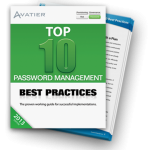Today’s business places some mighty widespread demands upon Identity and access management systems. They need identity management solutions with help desk password reset software that can perform automatic user provisioning and password reset ticketing.
For decades, organizations have passed along responsibility for their identity management password reset and user provisioning demands upon their IT departments. Unfortunately, this isn’t the mid-1990s and the additional demands companies’ IT portfolios include go well beyond making sure Windows 95 is up and running on every employee’s desktop PC. Computing environments have become more distributed, devices have proliferated, and enterprise information, whether on site, or cloud-based continue to grow in number and complexity. Then there are the cyber security threats posed via Web access and email not to mention remote access by outside devices — i.e., BYOD. And the protocols, tools and cyber security audit controls to manage all of the complexity have also increased dramatically. Delivering the basic tenets of password confidentiality, account integrity and access availability have become a time sink at best, a routine auditors’ nightmare and at worse a gateway to security vulnerabilities.
The effect is an exponential increase in the number, variety, integration complexity, and synchronization of user identification, authentication and access governance requirements across an enterprise.
So where do we go from here?
Oddly enough, the wisest choice may be to look at identity and access management before the dawn of the computer age when identity management and access provisioning were the responsibility of front-line business managers who oversaw the people in their own departments. They’re the ones who decided who “got in” and who could “see the files.”
In the age of distributed computer systems, this translates into breaking the multiple functions of identity management solutions into a series of discrete applications with limited breadth, but more focused depth of control. By breaking identity management into discrete disciplines, which includes help desk password reset software, you gain better accountability for user accounts and their access privileges.
There are at least five key areas of focus that an organization must pursue to automate help desk ticketing and bring an effective identity and access management practice to the business management level:
- Identity mining and analysis: Unless implementing an IT strategy from scratch, organizations will have multiple applications and services that maintain multiple user and resource lists. To proceed, they need to understand, resolve, refine and normalize those identity lists and remove duplicates, junk accounts and unnecessary or deleted accounts to create an authoritative identity list that can then be used effectively by front-line managers.
- Identity definition and user provisioning: Organizations will need to simplify and automate the process of creating, refining, and provisioning user access to resources with automated user provisioning software. Role creation and definition tasks should be distributed to individual team or business managers who best understand both needed access and user roles. Ideally, this practice should implement a service catalog approach that uses an internal “application store” with IT service catalog user provisioning software that enables both managers and individual users to request new or updated access through a user-friendly, shopping cart-style self-service portal tied to an automated approval management system. This encourages more consistent maintenance, which in turn increases overall security effectiveness while creating an audit trail of changes and approvals.
- Active directory group management: Group membership should be defined by rule sets whenever possible to help overcome an error-prone ad hoc process, and to enable reusable definitions based on validated roles and well defined business rules. This process should be tied to task automation to ensure that the results of those rule sets flow back into stakeholder applications such as HR or directory services.
- Compliance monitoring and audit: You user provisioning workflow should include software audit controls which enforce corporate policies and remove this burden form help desk professionals and IT organizations.
- Increase security at the point of identity verification: The practice starts with ensuring password security through periodic and systemic change/update, continues with increasing password strength according to corporate policy, and move into supplementary identity verification technologies such as biometric and token-based user validation—common access technologies for newer devices.
This move toward separating identity and access management into independent practices or process disciplines is reflected by an increasing number of tools and technologies focused at those individual practices. Task initiation is then distributed to both end users and team/business managers to increase accountability at the same time as increasing efficiency and auditability. This enables IT to strengthen tools and technologies as business drives process and accountability, and lays the foundation for modern service management and regulatory compliance/ standards conformance.
Not only does the organization then benefit from the increased effectiveness of its identity and access management solution, but also from by offloading the responsibility for identity management from the IT department, it is granted the ability to move from a drain on ROI to a profit center by granting it room to pursue innovation.
Watch the Avatier Password Management Product Introduction video to learn more about our password reset software solutions:
 Get Your Free Top 10 Password Management Best Practices Guide
Get Your Free Top 10 Password Management Best Practices Guide
Learn the Top 10 Password Management Best Practices for successful implementations from industry experts. Use this guide to sidestep the challenges that typically derail enterprise password management projects.




